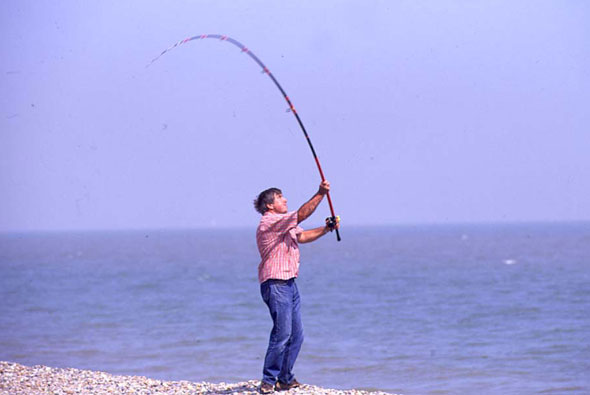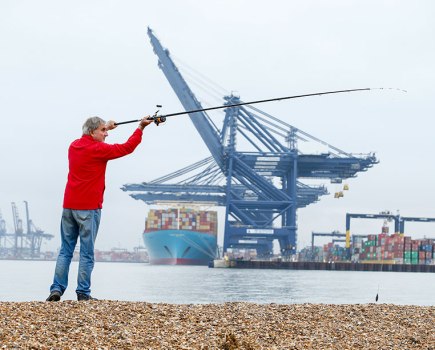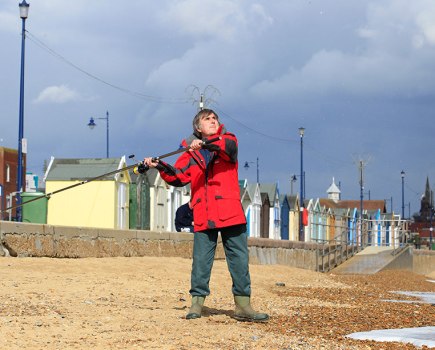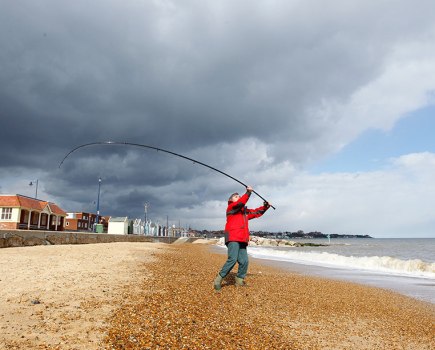In the good old days most beach anglers fished with the reel around 26in up the handle then casters realised they could alter the leverage of the rod by casting with the reel ‘down butt.’ Casting coach John Holden explains what can be gained from changing reel position and why you might get extra yards
Clamping a multiplier to the bottom of the handle position makes a huge difference at the top end of my casting range, regardless of whether I swing the sinker or drag it off the ground. I would never have made a really big cast, yet alone won tournaments, with a reel in the normal high position.
I’m talking here about high performance, not necessarily what works best for fishing, or even what feels good. With sinkers up to 5oz and distances of less than 175 yards – 90 percent of fishing duties – it makes not a yard of difference to me whether the reel sits high or low.
Tackle operation is excellent either way, with the exception of surf fishing when the rod must be held for long periods. In those circumstances, the high reel is a much more comfortable option.
Without watching you cast or knowing where and how you fish, I cannot say whether a low reel would offer any benefits. This issue of where the reel should sit on the rod for maximum performance is so crucial that everyone with the slightest interest in good casting should run a few tests to find out. For some it will be a disaster; for most it will make little or no difference other than to widen the options. For the lucky few it opens the door to massive improvements… and greater distances.
What does a low reel position do?

The best right-hand position must be found by trial and error. It will vary with sinker weight, rod specification and casting style. For most anglers, the right-hand grip will be within three inches either side of where the reel sat when in the high position
Shifting the reel up and down a rod handle alters the geometry of the tackle system. In particular, the point where the leader connects to the rod – the reel position, of course – has a significant effect on how the blank compresses and how quickly it recovers.
The technicalities and mathematics do not matter a great deal. All you need to know is that a rod performs differently when the upper hand grips the handle between the reel and the tip, as compared to the conventional high reel set-up where both hands are below the leader anchor point.
A low reel position changes the leverage within the system. When you cast with the same amount of effort as when the reel was high, the bottom and mid-section of the blank bend more.
Today’s beach rods tend to be so stiff and long that the majority of anglers cannot make them work properly, dropping the reel to the bottom has obvious advantages. The rod that tears your thumb off with the reel high often becomes a pussycat when the reel goes low.
Extra good news. Getting the reel out from under your right thumb allows a much firmer grip on the handle and more powerful use of the right hand, right shoulder and the body as well.
Arms-dominant casters punch their full weight. Body-biased styles can rotate with full force without having the right-hand connection break down under heavy pressure, which is a common problem with fast rods and high reels.
Other advantages include the option to use a longer rod, cast heavier sinkers and generally to improve timing and smoothness. Sinker release tends to be cleaner, which reduces bait damage and irons out spool surge and backlash.
But can I cast further?
This is the key question for so many fishermen. Sound style, extra power and a rod that works more efficiently add up to more fishing range. At the other end of the scale, poor styles gain little or nothing in the way of distance. Apoor style is always inefficient no matter what tackle you use.
It is the reasonably good caster who has most to gain. The common combination of a slightly dodgy style and an over-long, stiff, quick rod makes fishing a stressful game.
Having mastered the basics, he can cast pretty well most of the time. Yet the confidence just isn’t there. He knows only too well that the slightest mistake will end in yet another snap-off. Heavy sinkers are out of the question… anything less than big brake blocks or maximum magnet setting means big trouble.
Dropping the reel to the bottom of the handle softens and slows the rod so that it becomes tamer. The improved leverage allows him to exploit the extra length. Once familiar with the new arrangement, he begins to enjoy his fishing. It would be unusual not to gain another 20 yards as well.

A big advantage of the low reel position is that it allows a deep thumb grip on the spool. Using the rear coaster clip as a trigger for the index finger adds even more security. The icing on the cake is that fitting the reel to the bottom of the handle keeps leader pressure low anyway
Re-positioning the reel
Controlling a reel with the left-hand feels strange and awkward at first. It is something you have to get used to. With familiarity comes confidence, and within a few weeks you will forget that there was ever a problem.
For test purposes there is no need to modify the rod handle. Most high performance rods have plain butts. Re-positioning involves nothing more than sliding the coasters closer to the butt.
On conventionally built rods, leave the screw seat and grips alone. Standard foam rubber grips are too fat to allow normal metal coasters to slide on, so clamp on the reel just above the butt grip with Breakaway nylon reel clips that come apart so they can be slipped around the handle. Avoid over-tightening, and set the reel on a single wrap of rubber tape for security.
If the experiment works, you can strip off the butt grip and install metal coasters or a screw reel seat. The original screw seat can be taken off, though the rod is more versatile if you leave it on.
Screw reel seats are a handy option for heavy-duty fishing rods where coasters fail to provide enough security. Although slow to use, a two seat arrangement is ideal when you want to cast with a low reel but prefer the greater ease and better leverage of winding in with the reel up high.
Coasters are particularly good for hard casting because you can use the screw cap of the rear clip as a trigger. This, coupled with the deep thumb grip on the spool that comes with the low set reel, almost eliminates spool slip.
My favourite for fixed-spool work is a normal screw seat rather than coasters or a zip-up slider. Acheap and extremely good option is to bind on the reel with a strip of rubber cut from an old bicycle inner tube.
Wrap a layer on to the butt, lay the reel in place on top, then over-wrap the lot, finishing off by tucking the last two coils under themselves. Now you have a secure reel and a comfy grip combined.
Incidentally, you can control a low set fixed-spool with your thumb. The picture sequence shows how to do that. Personally, I find this a much-improved way to cast hard with a powerful rod and heavy sinkers.
Butt rings and leader knots
Other than purpose-built rods, most beachcasters converted for low reel work need an extra butt ring, 30-40mm diameter, to plug the massive gap between the reel and the original butt ring. Thirty-five inches from the reel is about right for multipliers.
Fixed-spools need a little more, but nothing excessive. I don’t buy the theory that fixed-spool fishing rods must have a few very big rings. Normal ring spacing and sizes are perfectly adequate.
Limiting the gap prevents line from flapping in the wind, but that is only half the story. The extra ring helps control leader flow and prevents the leader knot from catching in the butt ring, which is a risk with both types of reel. You may also need to experiment with the leader length as well.
Afew inches more or less wound onto the reel often produces a much smoother flow. It also helps to reduce scratches on the right wrist or forearm caused by the flick Scratches low on the wrist point to a stiff rod action. Towards the elbow, the rod is soft. Ideally, you want nice neat scratches about three inches up from the wrist.
Modifying the cast
Shift the reel and the cast’s feel and timing will automatically change. The classic sensation is that of a squashy rod – especially if the rod seems over-gunned with the reel set high. Quick and unforgiving with a high reel often becomes more relaxed and forgiving with the reel low down. Despite the softer feeling you lose neither power nor tip recovery speed.
Even if the sinker drop from tip ring to trace is set the same as it was when the reel was high, the overall leader length is now increased due to the difference in reel positions. Those extra couple of feet may mean that the elasticity of the material becomes noticeable, which can be disconcerting because it seems that you are losing power. This is rarely so, and nothing to worry about.
If you prefer a ‘harder’ leader, switch to heavier line or a less elastic brand. Bear in mind that a leader needs a certain amount of stretch in order to buffer against mistakes. Non-stretch materials are a poor choice for casting sea weights, and sometimes risky because they lack any form of shock resistance.

The space between the reel and butt ring can be quite critical with both multiplier and fixed-spool reels. It’s often necessary to add an extra ring to fill the gap, otherwise the leader knot will tangle in the original butt ring. A 30-40 ring taped on should do the trick,
The right-hand position
Right hand placement is something you must discover by trial and error. There is no single correct hand spacing for low reel casting. Hold the rod where casting feels comfortable and produces the best results. Your hand position should change to accommodate different weights of sinker, varying styles, leader drops and reel choice.
Roughly speaking, the ideal right-hand grip will lie between three or four inches either side of where the reel used to be before you switched it to the bottom of the handle. One position is unlikely to handle every combination of sinker, drop and casting style.
You are looking for a range of positions, each of them matching a specific set-up. To begin with, each must be found by experiment. In time, the process becomes second nature and you adjust the grip automatically.







